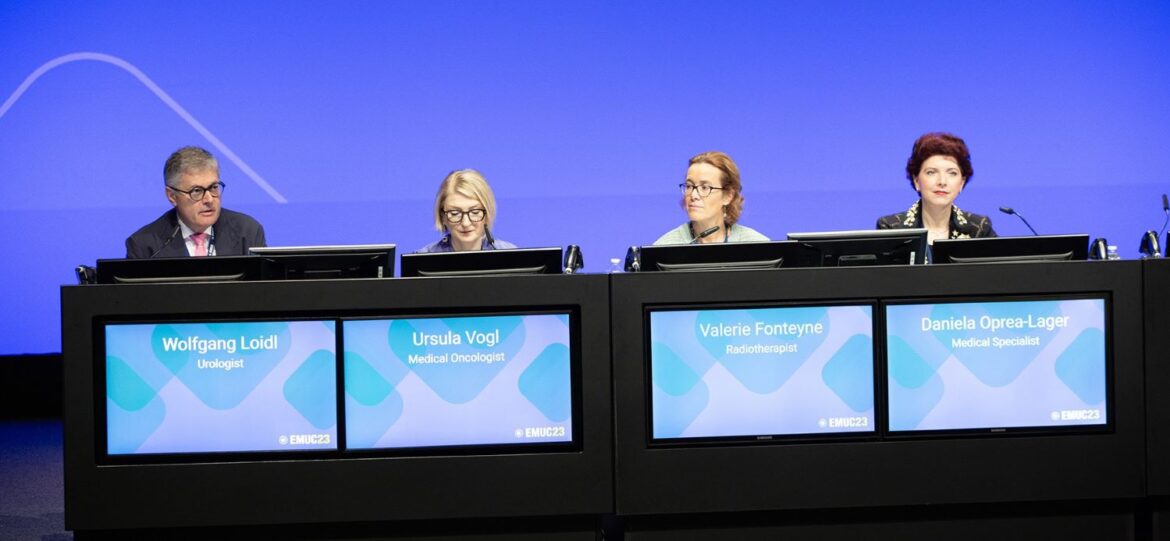The last day of EMUC23 began with Plenary Session 13: New standards and novel approaches in advanced prostate cancer, chaired by Dr. Wolfgang Loidl (AT), Dr. Ursula Vogl (CH), Prof. Valerie Fonteyne (BE), and Assoc. Prof. Daniela Oprea-Lager (NL).
“The train has left the station”, stated Prof. Alberto Briganti (IT) when talking about conventional imaging in his presentation on the role of local treatment in M1a disease. “The panel of a Dutch multidisciplinary consensus meeting agreed that PSMA is the most appropriate standard imaging modality to identify de novo M1a (100%).”
According to Prof. Briganti, treatment of the primary tumour is invariably associated with better outcomes. In the EAU Guidelines, treatment of the primary is strongly recommended with radiation therapy (RT) and there is no strong comparative data with surgery. He stresses that there is a need to invest in future trials.
Systemic triplet
In his lecture, ‘Intensification of systemic treatment for men with de novo M1 disease’, Prof. Karim Fizazi (FR) shared a robust rationale for the use of systemic triplet therapy. “Both androgen receptor pathway inhibitors (ARPI) and taxanes are active after one fails. Poly-therapy is needed to target heterogeneity as some cells are resistant to androgen receptors (AR) targeting and some others are resistant to taxane. Until we have a biomarker to tease out AR/taxane sensitivity, a combination is required.”
Prof. Fizazi shared his six good reasons to use systemic triplet therapy in fit men with mCSPC: “It works! This is not a false positive and the control arm was just standard treatment. There is no available comparative data for triplet versus bi-hormonal therapy but the benefit is likely. The biological rationale is strong, and lastly, there is balance with efficacy and safety.”
According to Prof. Fizazi, the standard of care for 2023 for de novo high volume in fit men is ADT+docetaxel+abiraterone/pred or darolutamide (or enzalutamide). If men are unfit for docetaxel, then ADT+NHT is possible. In de novo low volume cases, he recommended it is possible to treat with ADT+NHT+RXT (PEACE-1 RT data), although this is more complex and the systemic triplet, it should be discussed on a one-by-one basis in terms of age, fitness, bone health, etc.
Looking to the future, Prof. Fizazi shared details on the next generation trials stratified on clinical/molecular biomarkers, such as the PEACE-6 programme, which has several ongoing and planned European trials in M1 CSPC.
De-escalating in HSPC?
Prof. Bertrand Tombal (BE) presented a lecture on ‘De-escalating strategies in HSPC: who, when, how?’. He concluded that a significant proportion of patients achieve a profound PSA response (<0,2 ng.ml after treatment with ADT and an aRpl).
“Sub-analyses of the registration trials have consistently demonstrated that these patients have prolonged survival and, thus, prolonged exposure to treatment. There is an opportunity to revisit the concept of intermittent treatment as a strategy to reduce side effects, improve HR-QoL (health-related quality of life), and limit costs. This should be tested in clinical trials, properly assessing the risk and benefit of de-escalation.”
Prof. Tombol ended his presentation with some details of the new study ‘discrete choice experiment (DCE)’, designed in collaboration with EUROPA UOMO to understand patient’s assessment of the benefits and risks of intermittent versus continuous ADT (androgen deprivation therapy (ADT)). This study includes a qualitative phase with patient interviews and a discrete choice experiment survey for phase two.
You can watch a webcast recording of the full presentations on the EMUC23 Resource Centre.

